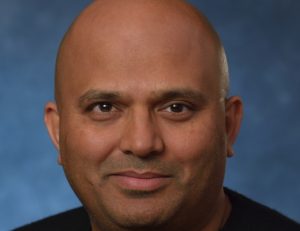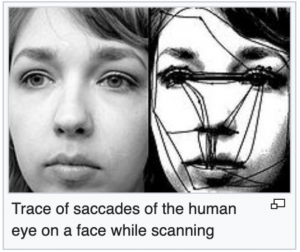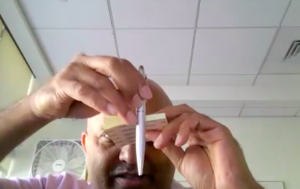Dr. Neeraj Gandhi is a professor at the University of Pittsburgh.
His research focuses on motor control, sensorimotor integration, and premotor theory of attention. He studies the dynamics of population activity during eye and/or head movements directed toward stationary or moving targets under various cognitive conditions. We talked with him on Zoom about a number of things, like ballistic eye movements, out-of-the-box primate tasks, killer sudoku, and why the superior colliculus is the coolest part of the brain. A special congratulation to Dr. Gandhi for his recent appointment to the Neural Control of Movement (NCM) Society Board of Directors!

*This transcription of the interview has been lightly edited for clarity. Alternatively, you can watch the interview on our YouTube channel.
Mintch: Can you tell us about what research you do and what your lab has been focused on?
Gandhi: Historically I was interested in how the brain controls eye movements. Approximately 5% of people in the world, including me, have strabismus – abnormal eye movements in which the two visual axes do not align and the eyes don’t always move appropriately with respect to each other. When I was young, I thought the problem was biomechanical – something was wrong with the muscles – but during undergrad I realized the problem was not with the muscles but rather the signals that come from the brain to the muscles. For my PhD I joined a lab focused on neural control of eye movements. Over the last two decades, I’ve become interested in the language the brain speaks for motor control in general, although I always use eye movements as my proxy.
Here’s an example of this “language of the brain.” Let’s say I say something to you in Hindi: तुम्हारा नाम क्या हे and then in English: “What is your name?” I transmitted a message in two ways, but you were only able to decode one. How is it that I can represent multiple dimensions of information while you were able to decode only one of them? Similarly, the superior colliculus (SC) has the ability to transmit messages in different ways but only a subset of them can be communicated to the brainstem circuit that controls the eye muscles.
Mintch: You mentioned your personal interest in strabismus– which, by the way, I had as a kid too. Is that still a clinical application of your research?
Gandhi: The research I do now isn’t closely associated with strabismus; it’s more related to neuropsychiatric disorders involving motor control. When you have a population of neurons, the relative temporal structure is important for its message to be functionally meaningful. For motor control, if those neurons are working in unison, they can be a potent signal for motor generation. ADHD has been linked with eye movement abnormalities. The ability to inhibit movements is impaired in this patient group. In terms of a neural signature, superior colliculus neurons emits bursts of action potential prematurely, and eye movements are produced earlier than anticipated, which is a behavioral correlate of an inability to inhibit movements.
Mintch: A lot of your work involves saccades. First of all, is it pronounced “sac-ayds” or “sac-ahds”? Second, tell us more about these movements.
Gandhi: Sac-ayds , sac-ahds , pot-ay-to, pot-ah-to. Pick your preference. Either is acceptable. Saccades are fast eye movements, and the most common type. Saccades are what you produce when reading or scanning your visual world. Even when your eyes are fixating on an object, they’re making micro-saccades about three times a second. Saccades are often called ballistic because of their fast speeds but, in reality, they are not ballistic but rather under internal feedback control mechanisms that preserve accuracy. Another type of eye movement is smooth pursuit, which we use to track moving objects; pursuit is very different from saccades. There’s also vergence, where the eyes move towards or away from each other depending on focal length. By and large, different types of eye movements are neurologically segregated– they each use different neural circuits but significant overlap does exist. Saccades have been my bread-and-butter.

Mintch: As I’ve read your papers, I’ve found that many of tasks you’ve set up for non-human primates are very unique. In one paper, you put a puff of air in animals’ eye to “reset” the ballistic firing. Tell us about this experiment and some other out-of-the-box primate tasks you’ve set up.
Gandhi: I had been thinking about this topic since I was a graduate student. We believe that saccades are controlled by a potent “gate”, which needs to be released in order to produce the movement. We wanted to figure out how to experimentally control the gate to better test its function. But how do you remove the gate? Lidocaine injections would inactivate it for 30-45 minutes, and muscimol renders it inactive for hours. I wanted some way to remove this gate easily, transiently, and with temporal precision. Optogenetics is potentially an option, but it doesn’t really work in monkeys. It turns out there’s a low-tech solution: deliver a small puff of air to the eye and make the animal blink, and the blink for some reason removes the gate.
Mintch: Had anyone ever done that before?
Gandhi: There’s always been a push to manipulate the gate. I did experiments in grad school where I’d re-introduce the brakes to interrupt an ongoing movement. But it wasn’t until this recent discovery that anyone had removed the gate with reasonable temporal precision.
Mintch: You mentioned that the SC is your go-to area for research. Tell us more about it.
Gandhi: I could talk about the SC for hours! Evolutionary speaking, the colliculus was the mecca of the brain before there was a cortex, and it still does a LOT. If you consider frogs, the colliculus is at the top of the brain. It’s super important in fish too. It’s also known as the tectum. It’s the premier site for interacting with the environment: taking in sensory information and issuing movement commands. My colleagues that work with larval zebrafish work on the tectum because it’s where sensory-motor integration happens. It’s a preserved structure that does amazing things. It’s a laminar structure that looks like sheets, seven layers, all stacked up, and neatly organized. Just like the visual cortex, the colliculus maps out the visual world.

Imagine these sticky notes are the SC and my pen is an electrode. What’s great about colliculus organization is that each layer of the SC will give information about a specific spot in the visual field– but top layers encode visual information, the bottom ones reflect motor information, and the middle ones represent both sensation and action. It’s beautiful like that.
When you see studies using electrode arrays, such as the Utah array, they’re typically studying the cortex and typically a region on its surface. Unfortunately, you can’t do that with the SC, because it’s near the brain stem, 20-25 mm below the cortical surface. You need a different approach, such a laminar probe. But I haven’t given up on the idea of doing an electrode array on the colliculus.
Mintch: I’m always curious what electrode changes would be needed to advance certain research, and it looks like you’ve already thought about this a lot.
Gandhi: I want to study a tiny cubic portion of the colliculus, and I hope to provide a 3D visualization of what happens in that little cube. If that works, I’ll have a rich dataset and I’ll probably have to spend the rest of my career analyzing all the data. Perhaps wishful thinking but I see no harm in thinking big.
Mintch: If you could try a new experiment to explore saccades, what would it be? You recently “took the brakes away,” and before you added brakes.
Gandhi: I’m high on this temporal structure aspect right now. There are a couple of competing ideas on how the same population of neurons can differentially encode sensation and action. I’d like to train animals in a BCI context to volitionally change the population response to test competing frameworks.
Mintch: Those are all the questions I had related to research. Our intern Annie has some questions that are more “out of the lab.”
Gandhi: These are the ones I’m going to trip up on, I bet.
Rauwerda: What made you interested in this field?
Gandhi: When I was 10 or 12 years old, I was laying in bed at my cousin’s house and he had a poster about NASA or something, and I blurted out that I would be a scientist someday. It amazes me that I remember that– and that it has come true. My own issues with strabismus paved the path for me. I started in BME as an undergrad at Boston University. When I got to grad school I worked with a fantastic mentor, Edward Keller, who once trained with the “pope of ocular motor research,” David A. Robinson. All of these factors have contributed.
Rauwerda: Have you had any light-bulb-over-the-head breakthroughs? How has progressed looked over the course of your career?
Gandhi: The closest thing to a lightbulb moment was the blink experiment. I couldn’t believe I could do something so low-tech and get a result. I was surprised no one had thought of that, and it was the early 2000s, so my mind wandered to military applications to combat terrorism. Also, the recent result associated with temporal structure. When my student showed me those results, I could not believe them.
Rauwerda: Who’s someone in the world that inspires you?
Gandhi: My parents have a lot of influence on how I handle myself as a person. I see my dad in me. Intellectually, I’m inspired by my PhD advisor Ed Keller, and the way he carried himself as a scientist and human being. I often also remember my high school Biology teacher – Ms. Grace Dreisbach – who saw something in me and introduced me to the world of science projects and science fairs.
Rauwerda: What’s something interesting about neuroscience or biomedical engineering for someone that doesn’t know a lot of background?
Gandhi: I tell this to my students. The Bible of neuroscience is, “Principles of Neuroscience” by Kandel, Schwartz, and Jessell. I tell people that there’s good news and bad news about that book. The good news is that half of what’s in the book is wrong. Students are usually a little perplexed but inquire about the bad news, to which I state I don’t know which half is wrong. I first heard that from Steve Lisberger, and I had to decide if I was going to be discouraged or if I was going to get excited about the opportunity to find out what is wrong. This story taught me to be very methodical and careful, and it’s made me a better scientist. Of course, half of what I do will be wrong too but so be it.
Mintch: I think that’s a fun part of science. You always have to be ready to be proven wrong.
Rauwerda: What do you do outside of work? Any hobbies?
Gandhi: Well, I work a lot. I run my lab, I teach, and I’m the graduate program director, including a new masters in neural engineering program I developed. So, I stay busy. When I’m not doing that, I spend time with my family. I also am a fan of single malts. I could just enjoy them forever. My other goofy hobby is playing killer sudoku, not regular sudoku. One website has a puzzle of the day which I just have to finish every day. I haven’t done it today yet and I’m just itching. I think I see you guys checking for the website right now.
Mintch: Wait, how is killer sudoku different from regular sudoku?
Gandhi: Some boxes have sums that the squares need to add up to. It adds another level of complexity which typically results in longer completion times. I’m an early riser, and most weekend mornings, I like to drink coffee, read the news, and finish my killer sudoku. I sometimes think I’ve got an addiction to killer sudoku.
This is the conclusion of this interview! Ripple would like to thank Dr. Gandhi for taking time out of his busy schedule to let us pick his brain a bit about his recent work and wish him all the best in his future projects!
